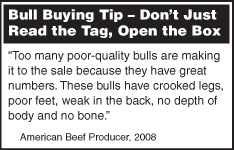



EPDs Provide Knowledge, Producers Provide Wisdom
By Kris Ringwall, Beef Specialist, NDSU Extension Service. “I have pretty much had it with the articles that talk about the importance of expected progeny differences and how great a tool they are for picking bulls,” wrote a producer who had read my column.After several BeefTalk articles on EPDs, this e-mail got my attention, especially because there is no perfect answer. Every coin has two sides and those who survive in the industry need to realize that.
Sometimes the questions are twisted and turned so they fit the answers rather than the answers actually being direct responses. In reality, all questions do not have answers. Many times, the challenge is to allow producers the freedom to ask a question.
Experience and the wisdom that comes from experience are common denominators for a long-lasting cattle operation. Experience and wisdom guide the knowledge we so often are presented.
Modern tools offer cattle producers an opportunity to tweak or, perhaps, steer for a little while a beef operation. However, the bottom line for cattle management needs to be embedded with knowledge and wisdom to put all the pieces together so a profit can be realized.

I would like to share the rest of the producer’s response.
“No wonder we pay so much for bulls. Seedstock producers spend a ton of money on their sales and sale directories. And like your article suggests, they then hope that people just show up on sale day, look out the window of their pickup and say, ‘Looks good from here and, boy, what great numbers!’
“Not only that, how many thousands of dollars are being spent on people running numbers just so we can estimate or expect what the progeny will look and perform like?”
Many producers offer me their opinions. As opinions, I respect them. Following these initial points, this producer goes on to offer some good advice.
“I use EPDs, but as a last review after I have thoroughly inspected each of the bulls that our ranch intends to purchase. I have been to places across Montana, the Northwest, Midwest and into Canada looking at bulls.
“Our ranch purchases more than 50 bulls a year and breed in some big country. Too many poor-quality bulls are making it to the sale because they have great numbers. These bulls have crooked legs, poor feet, weak in the back, no depth of body and no bone. How about having a bull that can breed a cow for four years and look as good at 2 and 3 years old as on sale day?
“We hold our cows to the same high standards. If a replacement heifer doesn’t get bred in 30 days, she goes down the road. If a cow does not get bred in 45 days, she goes down the road. If a cow has bad feet, bad udder, poor structure or, even worse, a poor calf, she goes down the road.
“How about knowing which bull has a greater percentage of breeding the most cows or which bull costs the least to own? When the industry starts putting some of those numbers out, I may pay more attention to the numbers. Those bulls would be worth more.
“As it stands now, the important numbers are pounds weaned per cow exposed, total cost noncalf revenue adjusted per hundredweight, pregnancy rate, weaning rate and annual cost/cow. Bulls play a major role in these numbers and I hope the seedstock industry starts paying more attention,” the producer concluded.
EPDs were not intended to be the end-all for selection. They are utilized only to aid producers in their overall program, not to be the program.
A sound beef program requires wisdom and knowledge. EPDs do add to the knowledge needed for selection for those traits that have EPDs.
Many traits in the beef industry do not have EPDs, so wisdom is called upon to put a total program together to make it work. There are no absolute answers to the bottom line, just a lot of pieces that, as this producer notes so well, all need to be considered.
April 2008


